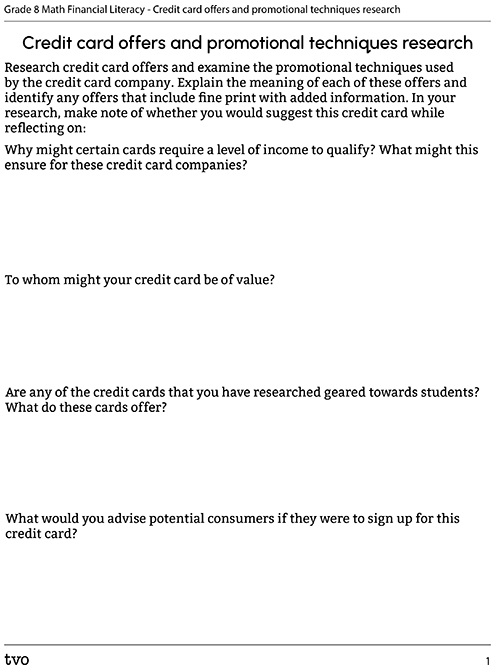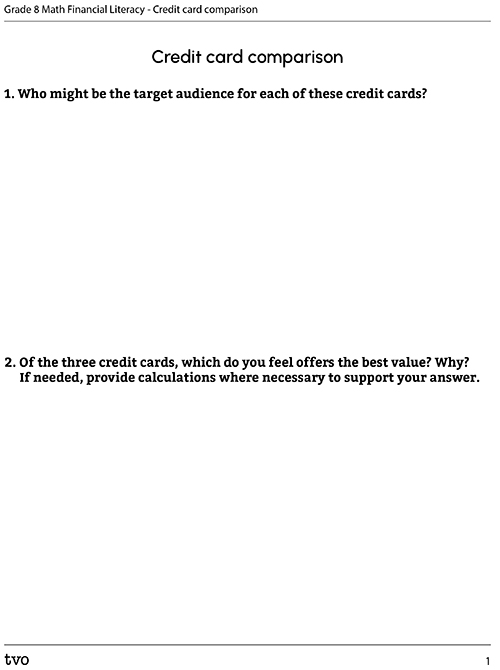Minds On
Credit card promotional offers
Consider the Canadian Bank Saver credit card promotion. The card offers a wide range of promotions for new customers.
Brainstorm
Examine the credit card offer
What are the target audience(s) for the promotions this credit card company is offering for this card?
How do you know?
Action
Credit card promotional offers
Banks and credit card companies are always looking for new and innovative ways to entice customers to sign up for their credit card. Strategies can include:
- introductory offers
- 0% APR for the first year
- the attachment of purchases to a rewards program
- no foreign transaction fees
- $0 annual fee for specific customers
These promotional offers vary from company to company and are designed to lure people in and have them spend their money. Some credit card companies offer rewards that can help make the most of spending. Be warned that if you do not pay off credit card statements in a consistent and timely manner, it will affect your credit rating.
Complete the Credit Card Offers and Promotional Techniques Research in your notebook or using the following fillable and printable document.
Research two credit card offers and examine the promotional techniques used by the credit card company. Explain the meaning of each of these offers and identify any offers that include fine print with added information.
In your research, make note of whether you would suggest this credit card while reflecting on:
- Why might certain cards require a level of income to qualify? What might this ensure for these credit card companies?
- To whom might your credit card be of value?
- Are any of the credit cards that you have researched geared towards students? What do these cards offer?
- What would you advise potential consumers if they were to sign up for this credit card?

Press the Activity button to access the Credit Card Offers and Promotional Techniques Research.
Activity (Open PDF in a new tab)Is it worth it?
Let’s explore three different credit card reward programs to determine whether or not they are of value. The following scenarios assume that the balance is paid in full each month and the credit card is not used for cash advances.
If you would like, you can complete the next word problems using TVO Mathify. You can also use your notebook or the following fillable and printable document.
Example 1: Grocery rewards
Credit card #1 has a $40 annual fee. Every dollar spent on your credit card will earn 10 points at the grocery store and every 10,000 points gives $10 off of a grocery bill. In one year, a customer makes $5,000 worth of purchases with this credit card at the grocery store. Compare the grocery store rewards in one year to the annual fee. Is the customer benefiting from the promotional offer?

Example 2: Cash back rewards
Credit card #2 has an $99 annual fee. With each purchase, customers will receive 1% cash back. In one year, a customer makes $8,500 worth of purchases using their credit card. Compare 1% earnings based on the spending to the annual fee. Is the customer benefiting from the promotional offer?

Example 3: Car rental insurance
Credit card #3 has a $140 annual fee. This credit card offers car rental insurance for up to seven days each year. A customer rents a car for seven days. The rental agency charges $25 a day for car insurance. Are they benefiting from this promotional offer?

Press the ‘Activity’ button for your note-taking document.
Activity(Open PDF in a new window)Comparing credit card offers

Now that you have had the opportunity to research and learn about promotional offers related to credit cards, let’s explore three sample credit card offers below.
Work with a partner or with someone at home, if possible, and discuss the cards and their offers together before beginning the activity:
| Financial Institution | Royal Bank of Canada | TD Canada Trust | Scotiabank |
|---|---|---|---|
| Card type | World Elite Mastercard | Platinum Visa | Gold American Express |
| Interest rate | 19.99 % | 19.99 % | 19.99 % |
| Annual fee | $0 | $89 | $129 |
| Minimum credit limit | N/A | $2,000 | $5,000 |
| Features |
Get an annual World Elite round-trip companion voucher starting at $119 CAD (plus taxes, fees and other ATC charges) Get up to 450 WestJet dollars – 250 welcome WestJet dollars plus earn an additional 200 WestJet dollars when you spend $5,000 in the first 3 months |
Earn 3 TD Rewards Points for every $1 in grocery purchases and regularly recurring bill payments Earn 5 TD Rewards Points for every $1 when you book travel online through Expedia. Earn 2 TD Rewards Points for every $1 you spend on all other purchases |
Earn 5 times Scotia Rewards points for every $1 CAD spent on eligible grocery stores, restaurants, fast food, and drinking establishments - includes popular food delivery and food subscriptions. |
| Minimum income | $80,000 | none | $12,000 |
After you have carefully reviewed each of the above credit cards and their respective offers, complete the Credit Card Comparison in your notebook or using the following fillable worksheet.
1. Who might be the target audience for each of these credit cards?
2. Of the three credit cards, which do you feel offers the best value? Why? If needed, provide calculations where necessary to support your answer.
Credit card interest charges

If you would like, you can complete the next activity using TVO Mathify. You can also use your notebook or the following fillable and printable document.
After comparing the three credit card offers, an author has decided to sign up for the Platinum Visa credit card described in the table. The account is activated on May 10.
1. Calculate the interest charged, at 19.99% simple interest, on the payment date of June 20th, if the credit card bill is not paid off entirely. Be sure to calculate the duration of time between May 10 and June 20.
2. Calculate the additional interest and total interest due on the following payment of July 20th if the author has yet to pay off their bill. *Note, you will need to use the compound interest formula to calculate this total interest.
3. How much will the author have paid including both interest and annual fees?
Press the ‘Activity’ button for your note-taking document.
Activity(Open PDF in a new window)Consolidation
Minimum payment and compound interest
Oftentimes, people may think that paying the minimum monthly payment towards a credit card bill is sufficient. With this logic, it will forever feel like you are chasing a balance and can’t keep up. What consumers fail to realize is that compound interest can result in costly interest charges if they do not pay off their balance every month.
Let’s explore the amount of interest that a consumer will be paying on their credit card balance.

If you would like, you can complete the next activity using TVO Mathify. You can also use your notebook or the following fillable worksheet.
Press the ‘TVO Mathify' button to access this interactive whiteboard and the ‘Activity’ button for your note-taking document. You will need a TVO Mathify login to access this resource.
TVO Mathify (Opens in new window) Activity (Open PDF in a new window)Reflection
As you read the following descriptions, select the one that best describes your current understanding of the learning in this activity. Press the corresponding button once you have made your choice.
I feel...
Now, expand on your ideas by recording your thoughts using a voice recorder, speech-to-text, or writing tool.
When you review your notes on this learning activity later, reflect on whether you would select a different description based on your further review of the material in this learning activity.
Join the conversation
Press 'TVO Mathify' to join the conversation and connect with a math tutor.
TVO Mathify (Opens in new window)